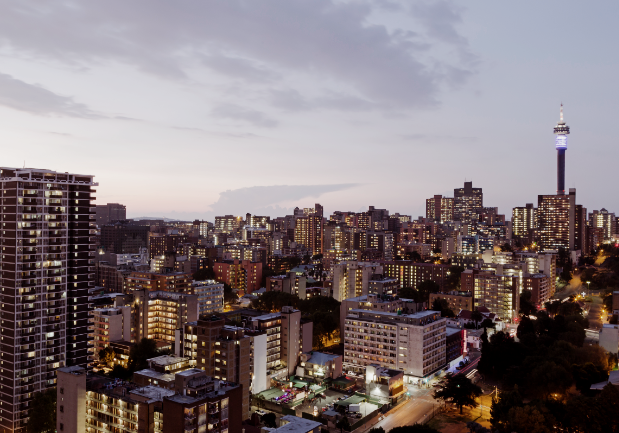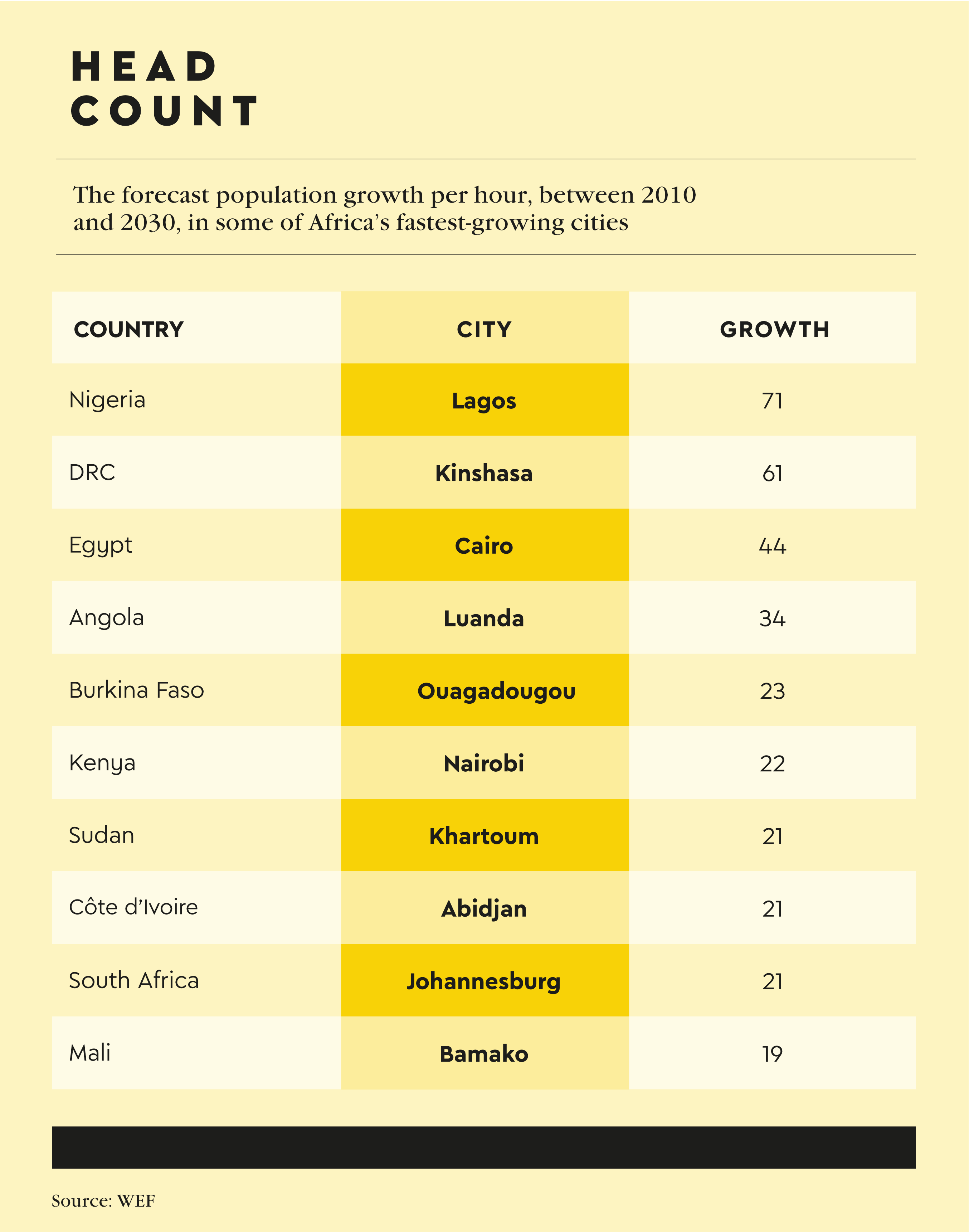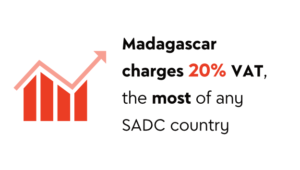African cities are growing at a frenzied speed. They are the places where the world’s changing demographics will become the most visible, as Africa’s youthful population is driving urban growth at a rate of 3.5%. This is the highest in the world, with the global average rate being 1.5% in 2022, according to the World Bank. One urban area in West Africa has been singled out as the world’s most rapidly urbanising region. A recent article in the Guardian describes how the coastal stretch between Lagos (Nigeria) and Abidjan (Côte d’Ivoire) is set to evolve into the planet’s largest zone of continuous, dense habitation by 2100. This future ‘megalopolis’ could be home to about half a billion people by 2035. ‘In just over a decade, the region’s small cities are either becoming major urban centres in their own right,’ the article states. ‘Or – as with places like Oyo in Nigeria, Takoradi in Ghana and Bingerville in [Côte d’Ivoire] – they are gradually being absorbed by bigger cities.’
People have always been drawn to cities, with their economic bustle, opportunities for work and education, and vibrant cultural life. Worldwide, an estimated 3 million people move to cities every single week, according to the International Organisation for Migration. That’s the equivalent of the entire population of Lusaka (Zambia), Algiers (Algeria), or Ouagadougou (Burkina Faso).
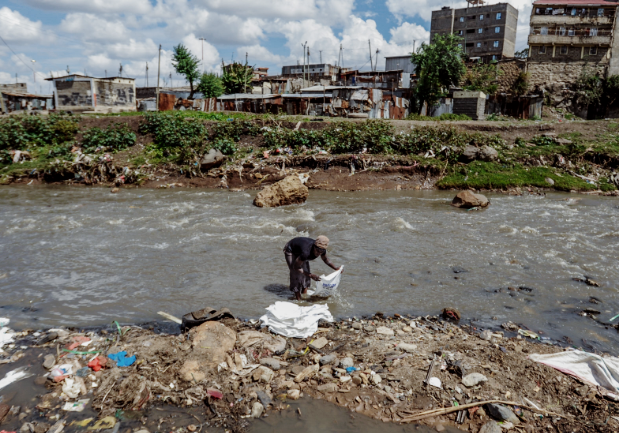
The UN notes that those living in cities now outnumber those in rural areas – the proportion of city dwellers has been rising continuously from 30% in 1950 to currently more than 56%. In many African countries, this ratio is even higher, notably in Gabon, where more than 90% of people live in urban areas – or Libya, with just over 80%, according to Statista. As of 2021, in Botswana, 72% of the population lived in cities, while in the Republic of the Congo, South Africa and Angola, it’s roughly 68%.
While urbanisation typically spurs on socioeconomic development, GDP growth and better living standards, rapid or uncontrolled expansion can do the opposite. It adds strain on already stretched metro municipalities through increased demand for services, housing, transport, schools, clinics, electricity and water, among others. ‘Urbanisation is often also directly linked to the degradation of environmental quality, including quality of water, air and noise,’ says Yaa Ngonyama, consultant at market research company Frost & Sullivan Africa. ‘Water insecurity remains a major developmental challenge in Africa, which is being exacerbated by the climate emergency and the lack of infrastructure development. Already cities are running dry, with the liveability of major cities compromised as bulk water supply runs short. Key challenges that are impacting the liveability of the cities include increased floods and droughts as a result of climate change.’
A new report by the UN University Institute for Water, Environment and Health, titled the Global Water Security 2023 Assessment, considers the entire population of Africa (1.3 billion people) to be water insecure. Yet there is enough water available on Earth to cater for Africa’s rapidly growing cities, says Anna Taylor, urban climate adaptation research fellow at the University of Cape Town’s African Climate and Development Initiative. ‘But only if we use and reuse water wisely and sparingly. Not if we develop our cities in the current model of existing global cities,’ she says.
‘We need to build, live, work, eat and care for our ecosystems in ways that value water as vital and precious, not as something that we consume at will and discard as waste after a single use.’
Perhaps surprisingly, 45 out of the 54 African countries in the UN Assessment scored ‘very high’ in the Sustainable Development Goal (SDG) indicator for measuring the level of freshwater availability. While this shows that the continent has more water available than it uses, most of the African countries in the assessment scored ‘very low’ for access to safely managed water and sanitation services, as well as the level of wastewater treatment.
‘For Africa to achieve its SDGs for water and sanitation – which means universal access to safe and affordable drinking water, and equitable sanitation and hygiene by 2030 – will require improved operations and maintenance, efficient management of water resources, the use of technology and digitalisation, and strengthened policy and regulatory frameworks,’ says Ngonyama. For all this to happen, she emphasises the importance of consistent investment into water infrastructure.
Water insecurity is one of the biggest – and grossly underestimated – risks facing cities across Africa, according to the World Resources Institute (WRI). ‘Inequitable access to basic water services, loss of natural water systems, unplanned urban expansion, and more frequent and intense droughts and floods will undermine the security, well-being and development prospects of Africa’s urban dwellers – 60% of whom live in slums.’
In an analysis of five cities in sub-Saharan Africa, the WRI found that in 2019 less than one-quarter of the urban population had access to safely managed water and less than half (42%) to safely managed sanitation services. The institute warns that African cities must improve their water resilience by, for example, ensuring communities have access to safe, reliable and affordable water, and that water resources are protected through disaster preparedness and water-sensitive infrastructure designs.
UCT’s Taylor says cities in Africa should prioritise the following water-related challenges. ‘Flooding from heavy rainfall due to inadequate drainage and infiltration; declining water quality due to pollution and poor waste management; and inequitable access to clean water due to infrastructure deficits, poor management and expensive costs.’
The infrastructure deficits are particularly visible in South Africa. After decades of poor planning and lack of investment in infrastructure maintenance to keep up with rapid urbanisation, the country’s ageing water storage, supply and treatment facilities are in crisis. Since 1996, the focus has solely been on providing new water access and services to the population, which has stretched the existing decaying infrastructure towards failure and collapse, says Anja du Plessis, associate professor and specialist in water-resource management at the University of South Africa. In an article in the Conversation, she writes that Gauteng (with its large cities of Johannesburg, Tshwane and Ekurhuleni) finds itself ‘in a perfect storm of major intermittent water supply due to continued power blackouts, high temperatures leading to above average water use as well as major continued water losses’.
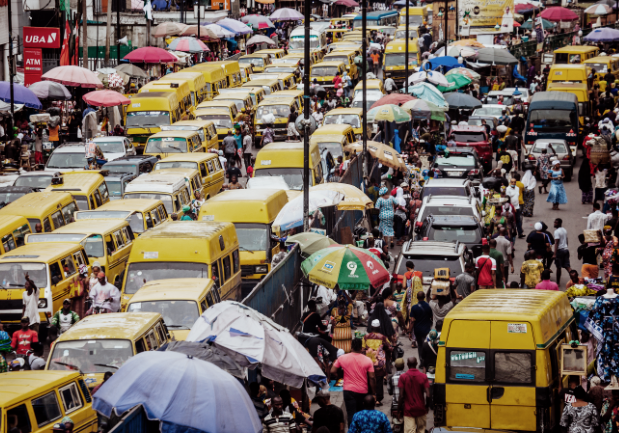
There are numerous reasons for the crisis, one of them being high ‘non-revenue’ water. In South Africa, 41% of municipal water does not generate any revenue (compared to global best practice of 15%), because it’s either physically lost through burst pipes and major leaks from the aged infrastructure, or commercially lost through meter manipulation and other forms of water theft, as well as unbilled authorised consumption such as firefighting, according to Du Plessis.
‘A suitable budget needs to be made available immediately to address priority areas. Proper planning and informed actions – not just promises – are a major requirement,’ she says. For Du Plessis, priority areas include urgent infrastructure upgrades, addressing lack of skills, implementing water conservation and demand management, and incentivising private-sector investment in water infrastructure.
Frost & Sullivan’s Ngonyama calls for a co-ordinated effort from national governments, municipalities and cities. ‘From a national perspective, there needs to be effective legislation that prioritises infrastructure maintenance, with money earmarked for infrastructure investment,’ she says.
At metropolitan level, city planners play a key role in solving the water crisis. Taylor lists some of the water-related tasks that this role entails, including spatially assessing and mapping water-related risks; prioritising areas for bulk and public infrastructure expansion; extension and maintenance; and linking technical expertise in bulk water supply, stormwater management, catchment management, environmental protection, water-demand management, urban design, landscape architecture and property development to maximise implementation of water sensitive technologies and practices.
‘Like, for example, prioritising, incentivising and supporting wetland rehabilitation; clearing invasive species from catchments; rainwater and stormwater harvesting at both the building and precinct scales; permeable paving; recycling initiatives to reduce clogging and contamination from solid waste, designing, siting and installing water reuse facilities; public awareness around the value and safety of water reuse; delineating aquifer protection zones and establishing development rules to protect groundwater sources, and so on,’ she adds.
In her research, Taylor provides examples of alternative practices and technologies that could potentially be scaled to strengthen urban water resilience, among them the Sihlanzimvelo, Transformative Riverine Management and Green Corridors initiatives in Durban, South Africa. Community-based co-operatives are contracted and upskilled to unblock and rehabilitate stretches of streams and rivers by removing solid waste and invasive plants, which reduces flood risks and upcycles reclaimed materials.
Taylor also mentions the Kigamboni decentralised wastewater treatment plant in Dar es Salaam, Tanzania, and highlights research on the social acceptance of new technologies that present an alternative to the lack of large-scale, centralised water-borne sewage systems and, as a result, reduce risks of cholera and diarrheal disease. ‘Similarly, we can learn from efforts in Accra, Ghana, to develop and test localised, on-site toilet-waste digesters to reduce the contamination of waterways and coastal waters from the disposal of sewage into the sea.’
As climate change and urbanisation are increasing the pressure on Africa’s cities, governments and their various partners must reimagine ways to collaborate in bringing water to the people while protecting the planet. Equitable access to water of sufficient quality and quantity is essential for the future of the continent’s cities.

